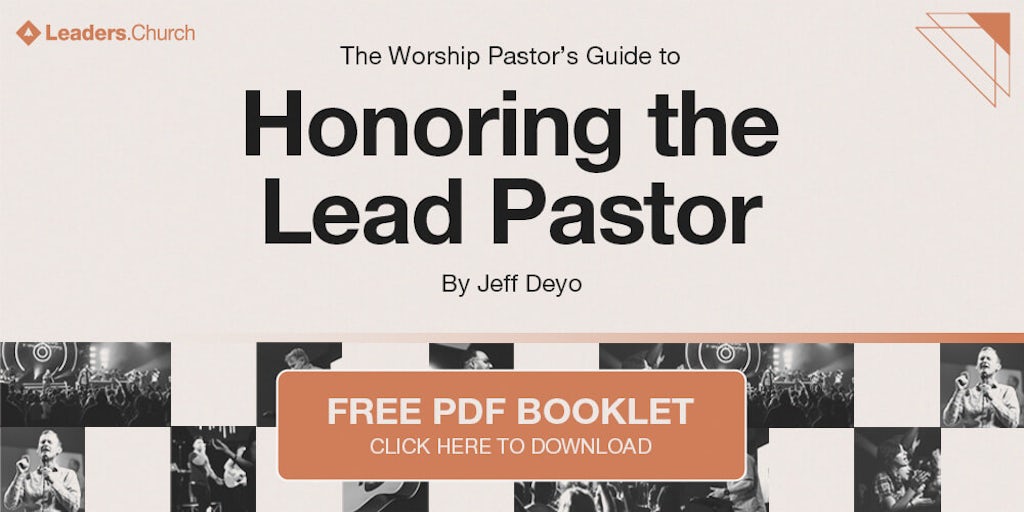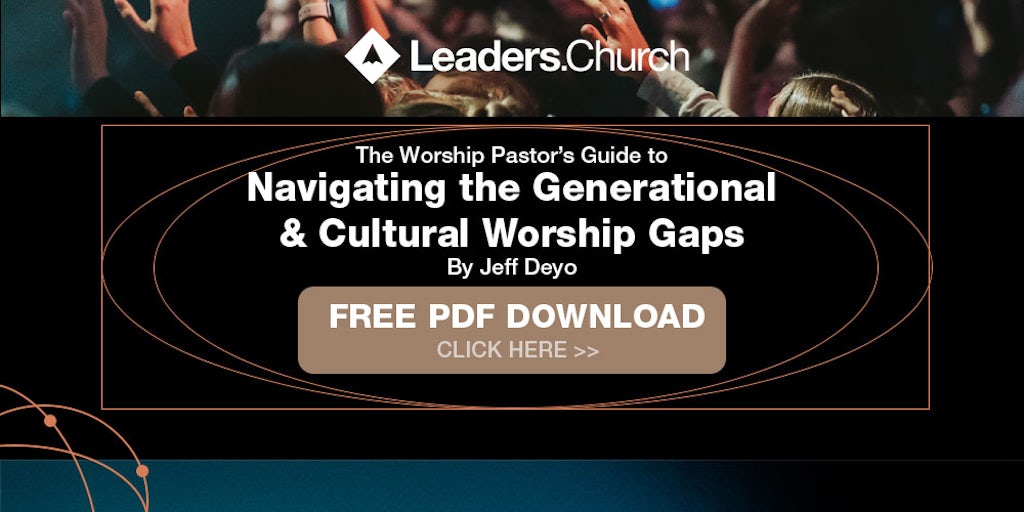
Your Guide to Smooth Transitions Between Worship Songs
Beyond a shadow of a doubt, the most overlooked rehearsal component for every worship team is transitions. You know, those often-so-awkward spaces between the songs, loaded with key changes, tempo changes, patch changes, pedal changes, and wardrobe changes—wait, no. Scratch that last one.
Let me set the stage. We’re cruising along brilliantly through one of our most beloved Elevation tunes when out of nowhere the end approaches. Oh no. The song itself has flowed flawlessly—we even hit that dramatic stop before the last chorus.
But in the rush of rehearsing each song in the set, we suddenly realize—with three bars left in the outro—that we forgot to work out the particulars of how to move from this song into the newly arranged—and quite spectacular, I might add—version of that new Mav City tune.
Gulp. Hope the band knows sign language.
Sometimes a transition is like two opposite sides of the Grand Canyon trying to join together seamlessly. We take a running leap off the edge of one song and desperately try to hang glide, parachute, high-wire walk, or even cannonball to the next one. Unfortunately, many times, if we’re honest, we forget to secure the high wire or pack the chute properly. We get so caught up with the intricacies of each individual song that we figure we can just wing the transitions.
Then the end draws near. Eyes dart between band members. The pad fades out too early. The drummer nervously scrolls to the next song and accidentally starts—and then stops—the wrong tempo. The worship leader says something canned to fill the space. The congregation looks down and pretends not to be there. Everyone on stage closes their eyes hoping to time-travel 120 seconds into the future. Crickets start chirping. Pins begin dropping. Microphones start squealing.
Then, after what seems like thirty-seven minutes, the next song begins, and praises arise—mostly out of relief that the moment has passed. All is fine. All is good. All is forgiven. All is forgotten. Disaster is avoided. Sort of. Right then and there we make a mental note to never let this happen again. Until three bars from the end of the next song. Oops. Next week.
And so, in honor of these treacherous transitions, let me share seven helpful hints that will turn them from tragic to terrific:
- Practice your transitions
- Be confident with your transitions
- Don’t underestimate your transitions
- Use words or singing to smooth your transitions
- Be authentic in your transitions
- Teach the congregation to worship through the transitions
- Be creative with your transition
1. Practice your transitions
This may seem painfully obvious, but the ultimate goal here is to make our transitions seamless. Seamless to the point where no one in the congregation notices them or is distracted by them. Not so we can be “awesome,” but to maintain the flow. Flow helps everyone stay focused on God. Flow is a good thing. Flow helps each song blend neatly into the next one like one stream merging with another. This takes practice.
2. Be confident with your transitions
If we’re uneasy about our transitions, the congregation will be too. This of course happens when we’re not properly prepared and may create unnecessary turbulence when flying at high worship altitudes.
Our feelings of apprehension are typically transferred to our passengers through small hesitations or indecision that can be as untimely as those seatbelt announcements right in the middle of a 37,000-foot nap. They pull people out of a deepening connection with God by creating a preventable disturbance. Of course, nobody has sinned here, but we all agree: less turbulence is better for maintaining favorable worship cruising altitudes.
3. Don’t underestimate your transitions
Songs in the same key with minor tempo shifts can fit together nicely. Yet, these simple transitions are often the ones that sneak up on us. We overlook them because they seem rudimentary, yet without proper communication, we can easily drop the ball here too. Working out the smallest nuances of the simplest transitions will go a long way toward cultivating team unity, even while preserving true communion in God’s presence.
4. Use words or singing to smooth your transitions
Oftentimes, instrumental music alone can make for a perfect transition. But sometimes, interjecting a prayer, a Scripture passage, or an exhortation can help massage problematic tempo and key changes. Be careful, though. Many leaders misstep in this area, using churchified clichés and empty hallelujahs (discussed in the next point) in an attempt to distract or “hype” the congregation.
Our main desire is to keep the congregation’s focus on God and away from tricky musical transitions. The mistake many worship leaders make is waiting until the next song starts—essentially AFTER the transition—to sing or say something, when, clearly, the best approach is for them to talk, sing, or read Scripture just before one song ends (during a crash-out or final chord).
The leader should continue over top the musical transition all the way past the intro of the next song in order to help meld the two songs together. I ask; “If we’re going to talk between songs, why wait until after an awkward musical transition instead of doing so over the entire transition?” Our aim should be to layer our exhortations over our transitions, and this will keep our congregations focused on the Creator rather than on the intricacies of our musical transitions.
5. Be authentic in your transitions
We certainly don’t need to speak between every song. In fact, I would encourage you to prepare a greater number of thought-out instrumental transitions, especially between up-tempo tunes. Then, when we do speak, it must not be manufactured, but concise, anointed, and heartfelt. We’ve all heard those robotic-like exhortations between songs that inevitably do the exact opposite of their intention. Attract and distract.
Remember to pray ahead of time to ask what the Spirit would have you say and then let it flow out sincerely. (I know some worship leaders who find it helpful to write out exactly what they want to say and memorize it so they don’t ramble on and on incoherently.) Sometimes I will simply pause for a split second and let the music at the end of the song carry the first part of the transition.
Then, relying on the Spirit’s leading, I step boldly and humbly into the moment, speaking to the people (or to the Lord) with all my heart. Of course, please steer clear of “Christianese”—common Christian verbiage—and always seek to draw from your times alone with God in the secret place.
6. Teach the congregation to worship through the transitions
This is big. Part of the challenge we face as worship leaders is establishing a culture where people realize they don’t have to stop worshiping when the band changes songs. Few churchgoers understand the concept of gliding right through the yellow caution light—to continually engage with their Creator—regardless of what the band is doing between songs, even if the transition is a complete disaster.
Thing is, we must teach these concepts to our spiritual family if we expect them to understand. Why make things difficult when we can easily encourage our congregants to resist slipping into spectator mode between songs by inviting them to sing or pray spontaneously with their own words and melodies during the musical transitions and instrumental sections? As a result, they’ll be able to neatly avoid lurching in and out of God’s presence with each change in the song.
7. Be creative with your transitions
God made us in His image. He is highly creative, which means we should be highly creative too. In response, you should let the Holy Spirit amplify your transition’s creativity, incorporating fresh melodies, rhythms, and swells to help you navigate the tempo, key, and feel changes. Check out these super-practical ideas designed to help you with even the trickiest of transitions.
7a When you have an odd key change
(Like C to B), you can sing the chorus of the first song a cappella a couple times. This is powerful and encourages the congregation to sing out. From here, as the last word of the a cappella chorus ends, pause sensitively and fade in the pad/keys in the new key. Voila!
Removing the chordal instruments distracts the congregation from the key change and allows the band to move astutely to the next song. Another creative technique to help smooth odd key changes is starting the next song with a drums-only groove. For example, if you end a song on the 1 chord in the key of A (and your next song is in Bb), try swelling on the A, and then, before fading out, click off the tempo of the next song and have the drummer play a creative four-bar groove that leads directly into the intro of the next song.
The band should wait to fade out the key of A until somewhere around the third or fourth bar of the drum groove so as to leave a little empty tonal space between the two songs. The drum groove serves as an inspirational distraction for the listener, allowing them to stay in the flow.
7b When moving between songs of different keys that share a chord or two
Try ending on the chord both songs share—often the 4 or 5 chord. This helps establish a new 1 chord—a new tonal center—for the new key. For example, when going from C to F, try ending on the 4 chord in the key of C (which is F) and swelling on it just long enough to establish it as the new tonal center for the key of F. Even if you’re moving from C to G, you can sometimes end on the 5 chord (G), thus establishing it as the new 1 chord for the new key of G. Intentionality is important.
7c When moving from a mid-tempo song to a slower song
Even from one slow song to the next, it really helps to create a definitive “ending.” Use subtle instrumental swells to communicate to the congregation that the song is coming to a close. Realize the congregation is constantly searching for cues without realizing it. They wonder (subconsciously) whether we’re singing the chorus again or going back to the bridge.
By swelling softly and even retarding slightly, we tell them that things are changing. This means, even if everyone except the keyboardist has stopped playing, others should swell in delicately on the final chord together—cymbals, guitar, bass, etc.
7d When going from one fast song to another in a different key
It works best to leave no dead space between songs (unless the space is very intentional). Why not just crash out boldly at the end of song one and then do a hard key change right into the next song? Follow the drummer’s lead as he starts the click for song two and counts it off BEFORE the crash-out from song one ends.
In other words, don’t fade out the crash ending completely until right as the next song begins (after the actual count-off). As always, definitely playing the downbeat of song two exudes confidence and assures continuity. In this way, we can get away with just about any key or tempo change.
7e When moving from a fun, up-tempo song to a slower song
Always avoid switching songs too abruptly. One effective technique is to sing the chorus of the up-tempo song at a slower tempo, one or two more times, with keys and guitar swells only. This helps lower the intensity of the up-tempo song while foreshadowing the mood change that is about to take place.
In this way, we utilize something from the song we just sang (lyrics) in order to blend it with something from the song we are about to sing (musical mood). This makes for a mucho grandioso transition-o.
Fun Story: I remember suggesting this type of transition to my NCU Worship Live team back in September 2019. They were attempting to flow between “Alive” and “It Is Well,” but since one song ends super big and the other begins super soft, it created an awkward moment. I encouraged them to change the intro of “It Is Well” and start with a full-band, anthemic instrumental (the 7/4 part). After the intro, they could simply drop into the first verse as usual. They tried it and loved it! I challenged them to stop thinking of each song individually and to start seeing the entire set as a whole.
We should always look to discern what creative musical modifications need to be made between songs in order to keep the flow. This approach keeps us from jerking people around in God’s presence and helps us revive older songs (or overly used songs) by making them less predictable.
7f When ending an up-tempo song
I highly recommend utilizing longer crash-out endings. I’m convinced people are longing to respond passionately to our exciting declarative songs, yet often they aren’t given much of an opportunity to do so when we crash out for three seconds and abruptly move to another song.
Playing a longer crash-out ending also helps us practically by giving the band more time to adjust pedals or add a capo, etc. Even more importantly, it provides the congregation the chance to celebrate more freely without worrying about getting caught singing or shouting loudly as the band dies down. Awkward!
If we allow these endings to extend just a few seconds longer—maybe even fifteen to twenty seconds total—people will learn that it’s “safe” to let go and praise God a little longer and a little louder. And that is a very good thing!
Anointing and Authenticity vs. Form and Function?
Some may read my extensive exposé on the importance of transitions and become concerned that by emphasizing these areas, we’ll miss the organic and raw presence of God. Honestly, it’s just the opposite.
True. People will survive if things aren’t “just so” in the transition department. Making musical mistakes or botching things between songs won’t prove to be the end of the Church as we know it. Unquestionably, we never want to crash and burn on anointing and authenticity while flying high on form and function. Yet, there isn’t any reason we can’t have both. There isn’t any reason we can’t strive for all of the above.
Why else would God design us with such amazing creative musical abilities if not to serve His people lovingly and exceptionally, genuinely, and extraordinarily? Much like a believer who builds a home, pilots a plane, or performs surgery with a passion to do his or her work with tender loving care and great attention to detail, smoothing the transitions between the songs increases the likelihood that our congregants will engage in the process without finding themselves overly concerned with potential mechanical failures.
This, too, is spiritual! It is a beautiful thing when servant artists concern themselves with skillfully and carefully operating the craft so others can sit back and enjoy the ride, unhindered, in the presence of the Lord.
Other Worship Leadership Articles:
6 Steps for Increasing Worship Team Effectiveness
8 Ground Rules to Run an Effective Worship Rehearsal
8 Things for your Worship Team to Rehearse
7 Compelling Reasons to Avoid Chasing Culture and Style When Leading Worship
5 Biblical Reasons for Spontaneous Worship in Your Church
4 Great Ways to Take Your Congregation to the Next Level in Worship





